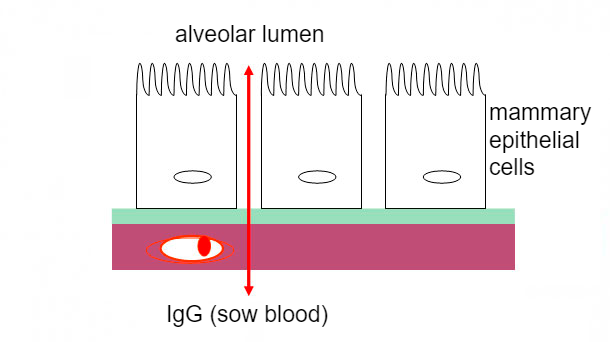Colostrum is essential for the survival and growth of newborn piglets (Figure 1) because it is their sole source of energy and it also provides passive immunity from the mother via the transfer of immunoglobulins. Furthermore, colostrum contains hormones, growth factors, enzymes, vitamins, and minerals that are all required for proper development of the piglets. Lacteal secretions are considered as colostrum for approximately 24 hours following parturition, they then become transition milk until 72 hours postpartum, to finally become milk (Table 1). This difference is due to the drastic changes in composition of lacteal secretions that take place in early lactation. There are marked decreases in concentrations of protein, immunoglobulins and growth factors and increases in fat, lactose and energy contents.
Table 1. Composition of colostrum, transition milk and milk in the hours and days after farrowing.

| Composition | Colostrum | Transition | Milk | |||
|---|---|---|---|---|---|---|
| 0 h | 12 h | 24 h | 36 h | 72 h | 17 d | |
| Protein (%) | 17.7 | 12.2 | 8.6 | 7.3 | 6.1 | 4.7 |
| Fat (%) | 5.1 | 5.3 | 6.9 | 9.1 | 9.8 | 8.2 |
| Lactose (%) | 3.5 | 4.0 | 4.4 | 4.6 | 4.8 | 5.1 |
| Dry matter (%) | 27.3 | 22.4 | 20.6 | 21.4 | 21.2 | 18.9 |
| Energy (kJ/100g) | 260 | 276 | 346 | 435 | 468 | 409 |
| Immunoglobulin G (mg/mL) | 64.4 | 34.7 | 10.3 | -- | 3.1 | 1.0 |
Currently, most sows do not produce enough colostrum to ensure optimal growth of their piglets. A piglet weighing 1.4 kg at birth should ingest a minimum of 250 g of colostrum in order to gain weight. The amount of colostrum produced is very variable from one sow to the next and is affected by circulating concentrations of various hormones. Oxytocin is a hormone that is frequently used in farrowing houses to help speed up the farrowing process, but it also plays an important role on milk quality in early lactation. Indeed, oxytocin affects the amount of space (tight junctions) between mammary cells. During the colostral phase these junctions are open allowing large molecules such as immunoglobulins to pass directly from the sow blood to the colostrum (Figure 2). After parturition, these junctions gradually become tighter to eventually be impermeable, thereby altering the composition of lacteal secretions and ending the colostral phase.

A trial was recently carried out at the Sherbrooke Research and Development Centre of Agriculture and Agri-Food Canada to study the potential role of oxytocin to prolong the colostral phase in sows. Twenty Yorkshire X Landrace sows of second parity were divided into two treatment groups. They either received saline injections (controls) or a very high dose (75 IU) of oxytocin 4 times in early lactation. The first injection was given 12 to 20 hours (average of 16 hours) after birth of the last piglet, and injections were then given twice a day at 08h00 and 16h30 totalling 4 injections. Litters were standardized to 11 ± 1 piglets on day 2 (day 1 was the day of farrowing) and piglets were weighed twice on day 2 (at a fixed 8-hour interval) and once on days 7, 14, 21 (weaning on day 22) and 35 postpartum. Suckling piglets had no access to solid feed. Four milk samples were collected, two on day 2 of lactation (morning and afternoon), and one on days 4 and 5 of lactation. Composition in terms of dry matter, energy, fat, protein, immunoglobulins G and A, lactose, sodium, potassium as well as concentrations of the growth factor IGF-1 was determined.
As soon as 8 h after the first injection of oxytocin, there were great differences in milk composition due to treatment. Milk from treated sows contained more proteins, immunoglobulins G and A, IGF-1 and energy compared to that of control sows. The sodium/potassium ratio was also much higher, indicating a greater opening (i.e. permeability) between mammary tight junctions. These differences were transitory because they were no longer present on day 4 of lactation. The weight gain of piglets did not differ between treatment groups but there was a tendency for a lower incidence of pre-weaning mortality in litters from sows receiving oxytocin. It is important to mention that the number of litters used was not large enough to be able to draw any conclusions as to the effect of treatment on animal performance.
We can conclude from this study that a single injection of a high dose of oxytocin given in the 16 h following the end of farrowing prolongs the colostral phase. This leads to an improvement in the quality of milk in early lactation. Increases in concentrations of immunoglobulins and growth factor IGF-1 in milk are particularly important because they have beneficial effects on immune status and development of the digestive system in newborn piglets. This is a novel finding in swine and the minimal dose of oxytocin required to elicit such positive effects remains to be established, as well as the impact of this treatment on performance and health of sows and their piglets.




